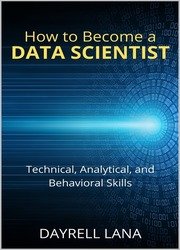 Название: How to Become a Data Scientist: Technical, Analytical, and Behavioral Skills
Название: How to Become a Data Scientist: Technical, Analytical, and Behavioral Skills Автор: Dayrell Lana
Издательство: Cerebro MLAI Limited
Год: 2020
Страниц: 147
Язык: английский
Формат: pdf, azw3, epub
Размер: 14.7 MB
From his over 20 years of comprehensive corporate and academic experiences, Dayrell Lana offers an essential guide for anyone seeking to become a Data Scientist or apply Data Science in organizations.
Data has become an asset for corporations allowing them to respond much faster to trends and customer needs. Collecting, transporting, and presenting data is mandatory to generate new insights and assisting the decision-making process. Data Scientists have a crucial role in supporting organizations to achieve these goals successfully. This five-part book comprehends the technical, analytical, and behavioral skills required to every Data Scientist.
In PART 1: The Data Scientist Role, we discuss Data Science and the Data Scientist role examining the duties, and the technical, analytical, and behavioral skills required for this position. The author describes how Data Scientists can overcome the challenges demanded by organizations and how relevant it is to work closely with business stakeholders. He also provides innovative insights using Gestalt phycology to deal with Data Scientists' knowledge limitation and the human bias factor that has been actively addressed in Machine Learning forums. The importance of the CDAO within a corporation is highlighted as well as how organizations can address Data Scientists' roles.
PART 2: Business Intelligence describes the most business intelligence practices and systems applied to organizations today and their relevance in developing businesses. We define business intelligence, BI tools, Data Analytics, Data Modelling, Data Quality, Data Cleansing, EDA/CDA, ETL, ELT, Data Warehouse, Data Lake, Data Mart, Data Mining, Hadoop, OLAP, Data Visualization, Data Presentation, and Big Data. The author dramatically points out the importance of Data Visualization, Data Presentation, and communication for Data Scientists, and how these practices and skills are vital to succeed in this career. He also shares a presentation approach informing the abilities and techniques to triumph in this task.
In PART 3: Machine Learning, we explore the most sophisticated machine learning techniques and how to perform them successfully in institutions. Machine learning has been transforming businesses rapidly and comprehending its concepts and applications has become obligatory to any professional who wants to be successful in any organization. We discuss the following techniques: the Machine Learning Process; Supervised and Unsupervised Learning; K-Nearest Neighbors; Training—Validation—Testing datasets; Overfitting and Underfitting; Regularization; Linear Regression; Least Squares; Gradient Descent; Normal Equation; Classification; Perceptron; Neural Networks; Logistic Regression; Decision Tree; Random Forest; Naïve Bayes; Clustering.
PART 4: Artificial Intelligence dives into the most significant artificial intelligence techniques present in many domains of business and society. Market and customers' needs have been challenging corporations to operate more efficiently and effectively, reducing costs and time-to-market. AI has been increasingly performed to overcome these issues. We examine AI applicability; AI Modern History; Intelligent Agents; Search Agents; Uninformed Search such as BFS, UCS, DFS, DFL, IDS, and Bidirectional Search; Informed Search; Adversarial Search and Games; Minimax Algorithm; Stochastic Games.
In PART 5: Applied Data Science Framework, the author shares a Data Science framework with you for machine learning projects, which is a result of many years of experience. This framework can offer you an opportunity to perform a standard of a business model for implementing Data Science projects. By applying it, from hidden data, you can provide your customers with valuable information, pattern, market trends, and new insights about their business, leading them to be more profitable. It can also be used for other Data Science practices.
Скачать How to Become a Data Scientist: Technical, Analytical, and Behavioral Skills